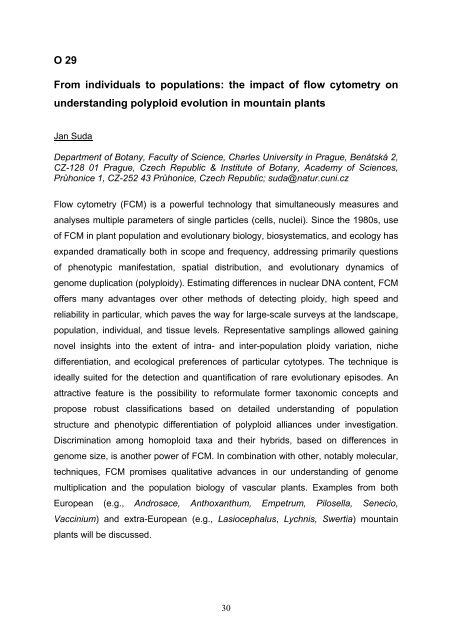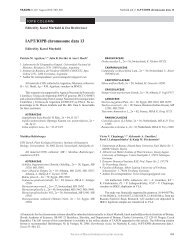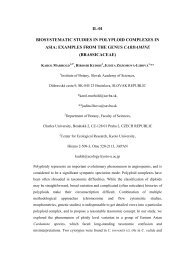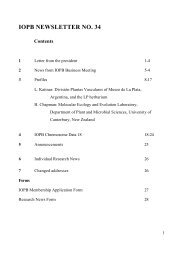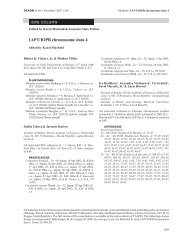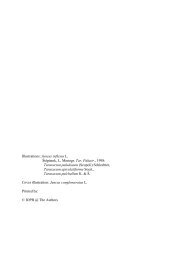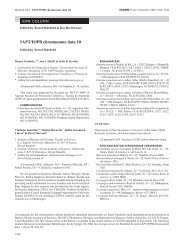CONTENS - International Organization of Plant Biosystematists
CONTENS - International Organization of Plant Biosystematists
CONTENS - International Organization of Plant Biosystematists
You also want an ePaper? Increase the reach of your titles
YUMPU automatically turns print PDFs into web optimized ePapers that Google loves.
O 29<br />
From individuals to populations: the impact <strong>of</strong> flow cytometry on<br />
understanding polyploid evolution in mountain plants<br />
Jan Suda<br />
Department <strong>of</strong> Botany, Faculty <strong>of</strong> Science, Charles University in Prague, Benátská 2,<br />
CZ-128 01 Prague, Czech Republic & Institute <strong>of</strong> Botany, Academy <strong>of</strong> Sciences,<br />
Průhonice 1, CZ-252 43 Průhonice, Czech Republic; suda@natur.cuni.cz<br />
Flow cytometry (FCM) is a powerful technology that simultaneously measures and<br />
analyses multiple parameters <strong>of</strong> single particles (cells, nuclei). Since the 1980s, use<br />
<strong>of</strong> FCM in plant population and evolutionary biology, biosystematics, and ecology has<br />
expanded dramatically both in scope and frequency, addressing primarily questions<br />
<strong>of</strong> phenotypic manifestation, spatial distribution, and evolutionary dynamics <strong>of</strong><br />
genome duplication (polyploidy). Estimating differences in nuclear DNA content, FCM<br />
<strong>of</strong>fers many advantages over other methods <strong>of</strong> detecting ploidy, high speed and<br />
reliability in particular, which paves the way for large-scale surveys at the landscape,<br />
population, individual, and tissue levels. Representative samplings allowed gaining<br />
novel insights into the extent <strong>of</strong> intra- and inter-population ploidy variation, niche<br />
differentiation, and ecological preferences <strong>of</strong> particular cytotypes. The technique is<br />
ideally suited for the detection and quantification <strong>of</strong> rare evolutionary episodes. An<br />
attractive feature is the possibility to reformulate former taxonomic concepts and<br />
propose robust classifications based on detailed understanding <strong>of</strong> population<br />
structure and phenotypic differentiation <strong>of</strong> polyploid alliances under investigation.<br />
Discrimination among homoploid taxa and their hybrids, based on differences in<br />
genome size, is another power <strong>of</strong> FCM. In combination with other, notably molecular,<br />
techniques, FCM promises qualitative advances in our understanding <strong>of</strong> genome<br />
multiplication and the population biology <strong>of</strong> vascular plants. Examples from both<br />
European (e.g., Androsace, Anthoxanthum, Empetrum, Pilosella, Senecio,<br />
Vaccinium) and extra-European (e.g., Lasiocephalus, Lychnis, Swertia) mountain<br />
plants will be discussed.<br />
30


